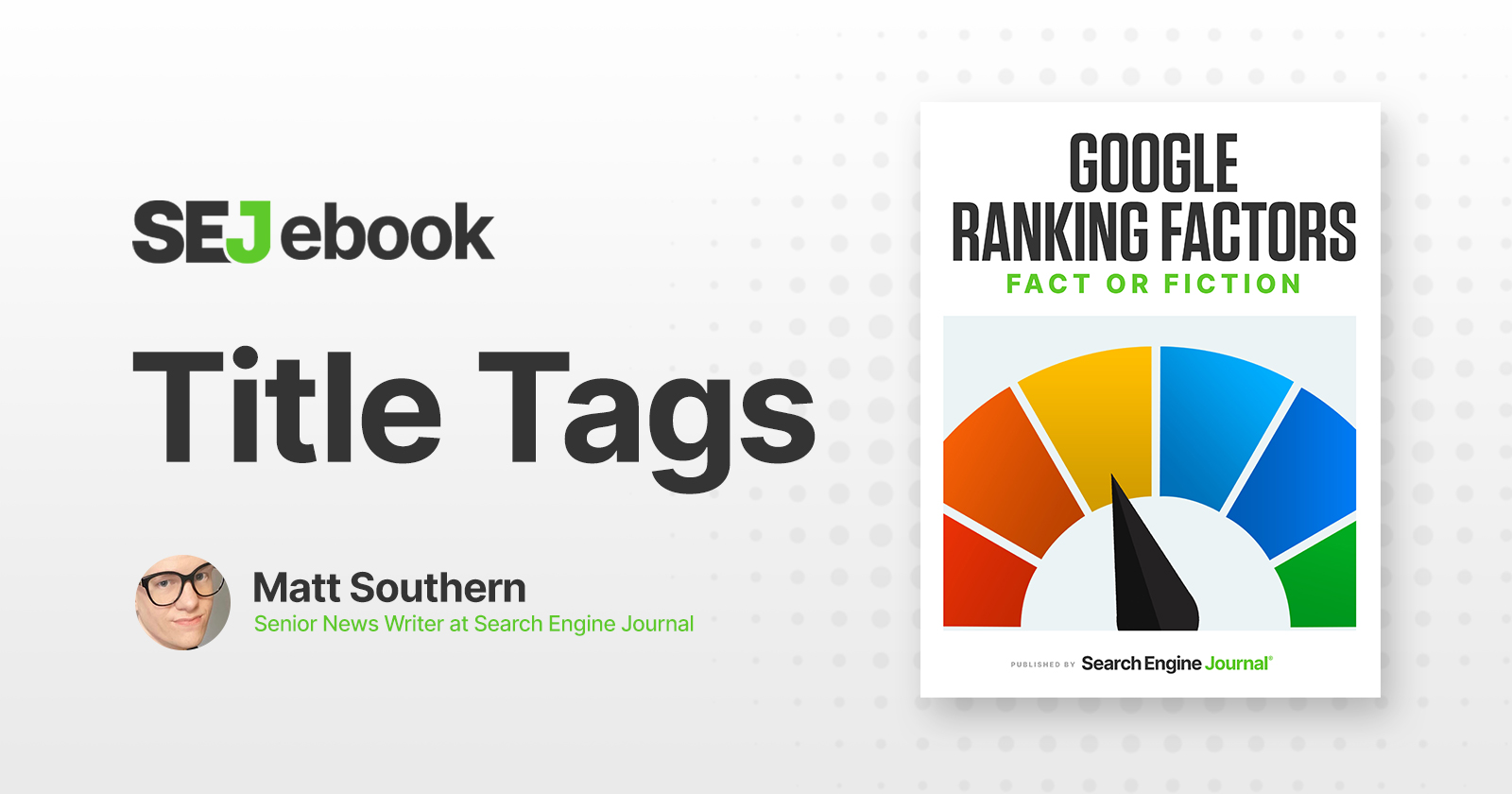7 Ways To Use Email To Boost Organic Traffic via @sejournal, @brentcsutoras
Here are seven steps you can take to leverage your email campaigns for SEO. The post 7 Ways To Use Email To Boost Organic Traffic appeared first on Search Engine Journal.

It’s the bread and butter of your career, but possibly also the bane of your existence.
Calling to targets like a siren’s song, whether they’re in the office down the hall or on a beach vacation across the world, it’s nearly inescapable. And, the modern world couldn’t function without it.
Of course, we’re talking about email marketing.
Typically a softer sell than other types of marketing, it offers incredible ROI, returning on average $36 for every dollar spent.
But, what is it exactly?
According to Wikipedia, email marketing is “the act of sending a commercial message, typically to a group of people, using email.
In its broadest sense, every email sent to a potential or current customer could be considered email marketing. It involves using email to send advertisements, request business, or solicit sales or donations.”
For digital marketers, this means primarily one thing: directing recipients to a website, either for more information, to make a purchase, or to perform some other action.
In other words, traffic is the name of the game.
But, can you really use email marketing to boost your organic traffic? Of course!
A key part of search engine optimization (SEO) is off-page factors, including social media shares and backlinks.
High-quality traffic will also affect how your site is ranked by Google and other search engines.
And, one way to encourage all of these is through effective email marketing.
So, let’s look at the $10,000 question: HOW do you use email marketing to drive traffic?
Here are seven ways you can increase visits to your website:
1. Target With Accuracy
Bounce rate – it’s a dirty word in online marketing.
And while there is such a thing as email bounce rate (that is, emails that were returned by the recipient’s server), what really matters to digital marketers is website bounce rate, i.e., the percentage of visitors who leave your site without taking action.
This is where email marketing can really shine. Whether you’ve bought your list or compiled it on your own, you should be equipped with some basic information about your audience, which will allow you to run highly targeted campaigns.
To improve traffic, your email campaign should go to people who are genuinely interested in your content, whether because they’ve expressed some interest in the past or your content can help solve a current pain point.
These types of visitors are likely to spend a longer time on your website, which signals to search engines that your website is a good resource. Google will recognize your site’s authority and increase your ranking accordingly.
2. Understand User Intent
Why are your email targets opening your messages? Because you’re offering them something of value and they see some relevancy in what you’ve sent them. (Or maybe you just write the world’s best subject lines.)
There are three main types of user intent and email marketing can be used for all of them:
Navigational – in which a user is trying to get to a certain site, in which case, congratulations, job done. Informational – where a user is looking for information. Transactional – when a user is prepared to buy or take another online action.If you’re also running your organization’s SEO, you’re probably familiar with this concept.
If not, get with whoever is and ask them for the long-tail keywords or descriptive searches that are driving people to your site.
Then, use these to craft email messaging that will connect with your audience.
By providing content that addresses user needs, you’re weeding out low-quality visitors, enhancing your SEO via an improvement in quality visits.
3. Use Newsletters With Exclusive Content
Once you know what your target audience is looking for, you can create content to address it.
And, regular newsletters with exclusive content are a great way to keep your brand at the top of a consumer’s mind.
Show your audience your brand’s value and establish a reputation as a thought leader in the field by sending out a weekly or monthly email with relevant information.
If you have a company blog, this is a great source you can mine for content that your audience won’t get anywhere else. And by clicking on the “read more” in your newsletter, they’re doing exactly what you want – visiting your website.
4. Integrate Email And Social Media
On their own, both email and social media marketing are useful tools. But when combined, the effectiveness of both grow exponentially.
Use your social media presence to invite followers to subscribe to your email list and vice versa.
This will not only build rapport, but will also let you develop more personalized communications.
Include “Share” tags in your emails so recipients can cross-promote content.
Incentive-based referrals are another effective marketing tool you can use to engage with customers, e.g., “Follow us on Facebook for 10% off” or “Send this link to a friend for an exclusive ebook.”
Sharing email content like this can drive both searches and traffic to your website.
5. Personalize Your Email Content
Which email message do you think is going to get a better response: One with a generic opening like “Dear customer,” or one that says “Jeff, we have a special deal just for you!” (Assuming your name is Jeff, otherwise that would just be weird).
As a marketer, you probably already know: that personalized emails have better open rates and click-throughs – and that’s just when they use the recipient’s name.
If you really want to maximize the impact of your emails and drive traffic, you need to be taking advantage of segmentation.
By dividing your list into smaller groups based on specific criteria, you can provide relevant content that is more likely to get clicks.
For example, let’s pretend you’re running an email campaign for a computer store that sells both Macs and PCs.
By segmenting your list into those with Macs and those with PCs, you can ensure your content is pertinent to the recipient.
You could do a shotgun approach, but the amount of people interested in both is probably minimal, so you start to run the risk of becoming annoying and driving unsubscribes.
And even if your audience doesn’t open your email, your brand name will still be in the back of their mind, so the next time they do a web search, you’ll be familiar and more likely to receive a click.
6. Conduct A/B Testing With SEO Keywords
We touched on this briefly in number two, but it bears repeating; your email campaigns should be using A/B testing, just like your landing pages and other content.
You should be trying out different versions of emails using SEO keywords to determine which get the best results.
Experiment with placing your brand’s most popular search terms in subject lines, preview text, and body copy.
What’s great about this is that it works in reverse too – finding you’re getting great results with a certain keyword in emails? Try adding it to your SEO terms and it will help drive traffic to your site.
7. Ask For Reviews
Every brand will claim it’s the best in its field. But consumers know this and take it with a grain of salt.
Reviews, on the other hand, have a much larger influence on decisions because they give legitimacy to your marketing claims.
After all, 98% of consumers read reviews. People tend to trust online reviews as much as personal recommendations.
And smart marketers like you know email marketing is a great way to solicit them.
One of the most effective times to send them is post-purchase when the newness of your solution is still fresh in the customer’s mind.
Personalize your emails and include links to review sites to make it easy. Keep your email short, and you’re much more likely to get a response.
If you’re doing email marketing for a local business, asking for reviews is especially helpful. They will not only impact your ranking in local search results, but they also let customers feel like they’re helping someone in their community.
Email Marketing And SEO Go Hand-In-Hand
Your digital marketing channels are all pieces of a much larger campaign.
They’re all connected and by taking a holistic view, you can use them to your advantage and help each perform better.
If you improve the quality of your email marketing, you’ll drive more qualified traffic to your website.
You can also direct targets to specific pages where they’re more likely to have longer visits and engage with your content. This, in turn, increases their likelihood of converting.
Sending your content via emails also earns more shares and attracts more visitors. It encourages other sites to backlink to your content, thereby boosting your credibility.
And all of these working together help make your SEO efforts more effective.
More Resources:
11 Powerful Email Marketing Tips You Need to Know How To Succeed At Email Marketing In The Competitive Travel Space Content Marketing: The Ultimate Beginner’s GuideFeatured Image: NicoElNino/Shutterstock

 Tekef
Tekef 































